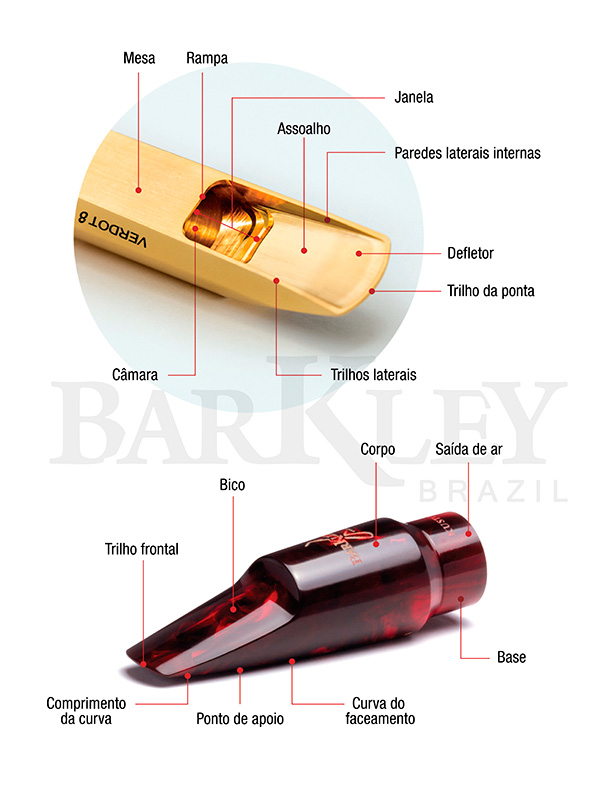PART OF THE MOUTHPIECE
Baffle The part of the mouthpiece directly behind the tip rail. The shape of the deflector determines the sharp “glare” or “dark” bass frequencies of the mouthpiece as well as its “hum”.
Body Part of the middle of the mouthpiece where the clamp fits.
Beack The front of the mouthpiece that the mouth fits to touch. Extends from tip to mouthpiece body.
Hole (Bore) The inside back of the mouthpiece that fits into the saxophone's tudel.
Break Point The point where the reed first separates from the flat surface of the table. The start of the face curve.
Chamber The open area in the middle of the nozzle between the floor and the hole. A large camera produces a fat and spreading sound, while a small camera produces a more focused sound.
The Camaro is clearly the most attractive and appropriate for the road, while the Fiat 147 will take you around the neighborhood, but getting on the highway with it will be a life and death experience no matter who is driving! < / p>
Chamfer The chamfered edge on the side rails that surrounds the entire window.
Curve Facing This is the longitudinal curve, starting at the fulcrum and ending at the tip rail. The face curve can be seen in a mouthpiece from the side. This curve varies widely between mouthpiece brands and plays a crucial role in the response the mouthpiece will have. It is very important that the facing curve on both side rails is parallel or uniform (unless intentionally uneven for a specific purpose). It is also important that the curve be continuous and gradual, without flat points or undulations.
Facing Curve Length The distance from the fulcrum to the nozzle tip, ie the distance from where the thinnest gauge thickness gauge reaches to the tip of the mouthpiece; This distance is always measured in millimeters. The response of the bass notes in a saxophone depends on that length.
Floor The inside of the mouthpiece behind the baffle and before the chamber. The larger this section, the more projection the mouthpiece will have. The smaller it is, the darker the mouthpiece will be.
Front Rail The front radius of the mouthpiece. It is the part of the mouthpiece where if its thickness is large it generates greater air resistance, and if it is small it generates less resistance.
Inner Side Walls The walls inside the mouthpiece that extend from the floor to the side rails. These are usually either concave (like an Otto Link) or flat (like a Brilhart and most clarinet mouthpieces).
Ramp The bottom of the table. It starts at the back of the window and leans down into the mouthpiece chamber.
Shank The entire outside of the mouthpiece just behind the table, which is closest to the saxophone tudel.
Side Rails This is where the pick is sealed to each side of the window. They are where the reed vibrates.
Table The flat part of the mouthpiece where the reed is seated, and the clamp holds the reed.
Throat The area inside the mouthpiece where the Camera transits to the Bore. The throat can be round, horseshoe (like Soloist Selmer) or square (like Selmer S-90 nozzles).
Tip Oppening The distance between the reed and the front rail. The larger this opening, the more air should blow into the mouthpiece; The smaller this opening, the less air should blow into the mouthpiece.
Tip Rail Located at the tip of the mouthpiece, this is where the tip of the blade joins and seals with the mouthpiece as it vibrates. The thickness of the tip rail helps determine the nozzle response. If it is too thin, the mouthpiece may "chirp". If it's too thick, the mouthpiece may sound "dead".
Window The open area of the mouthpiece that extends between the tip rail and the table between the two side rails.


